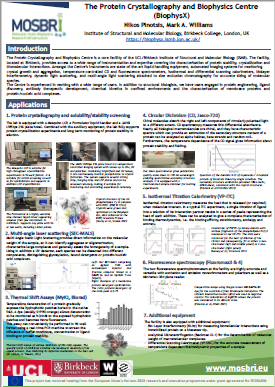9) ISMB-BIOPHYSX- Protein Crystallography and Biophysics Centre, Birkbeck College, University of London
Location: London, United Kingdom
Web-site(s):
MOSBRI reference site for the following techniques:
MALS: Multi-Angle Light Scattering

Partner description
ISMB-BIOPHYSX is a multi-technique biophysical characterization facility of the UCL/Birkbeck Institute for Structural and Molecular Biology (ISMB), providing supported access to instrumentation for ISMB and external researchers. ISMB has more than 70 associated research groups concerned with structural, biophysical, computational and chemical research into biological mechanism.
Instruments / methodologies offered through TNA
We offer access to:
- Spectroscopy: Fluorescence with plate reader and anisotropy, UV/Vis double beam, CD, UV/Vis/fluorescence stopped-flow. All spectroscopic instruments are capable of temperature-dependent study from 5-90°C.
- Molecular interaction detection: BLI, DSF (dual dye/wavelength system supporting soluble and membrane proteins), ITC, DSC.
- Screening & sizing: Robotic nanolitre pipetting for solution condition screening, DLS and SEC-MALS.
It is expected that most access will be through one of two pipelines:
- Protein sample optimization: – robotically assisted screening of solution conditions, thermostability screening by DSF, DLS to establish size homogeneity and identify undesirable soluble aggregation. Well-established factorial screens of buffer/detergent/amphipol for soluble and membrane proteins are available. Further study of promising species/conditions by SEC/MALS to enable analysis and isolation of stoichiometrically defined species.
Multi-technique interaction studies: Depending on the system and prior knowledge, a combination of interaction methods (BLI/ITC/UV-Vis/FRET/fluorescence) and methods primarily providing structural information (CD/DSC/DLS/SEC-MALS) will be selected to characterize binding events, and detect and understand, or rule out, coupled reactions such as oligomerization or conformational change.
Access modality: Access will be 3-4 days long, with normally two instruments in a pipeline in use simultaneously. Both physical and remote access are provided for protein sample optimization. Multi-technique interactions studies will usually be delivered via physical access.

